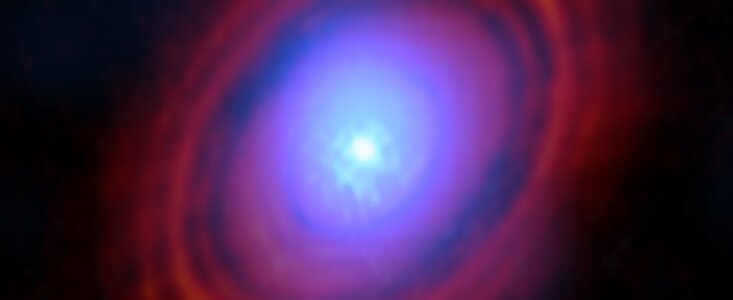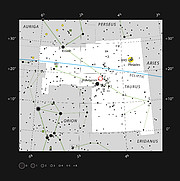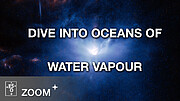Komunikat prasowy
Astronomowie ujawniają nowy związek pomiędzy wodą i powstawaniem planet
29 lutego 2024
Badacze znaleźli parę wodną w dysku wokół młodej gwiazdy odkładnie w miejscu, w którym mogą formować się planety. Woda jest kluczowym składnikiem dla życia na Ziemi. Uważa się też, że odgrywa znaczącą rolę w powstawaniu planet. Jednak do tej pory nie byliśmy w stanie uzyskać map rozmieszczenia wody w stabilnym, chłodnym dysku – rodzaju dysku, które oferuje najbardziej korzystne warunki do powstawania planet wokół gwiazd. Nowe wyniki były możliwe dzięki Atacama Large Millimeter/submillimeter Array (ALMA), w której Europejskie Obserwatorium Południowe (ESO) jest partnerem.
„Nigdy nie wyobrażałem sobie, że będziemy w stanie uzyskać obraz oceanów pary wodnej w tym samym obszarze, w którym przypuszczalnie powstaje planeta” mówi Stefano Facchini, astronom z Uniwersytetu Mediolańskiego we Włoszech, który kierował badaniami opublikowanymi dzisiaj w Nature Astronomy. Obserwacje ujawniają co najmniej trzy razy więcej wody niż we wszystkich ziemskich oceanach, występującej w wewnętrznym dysku młodej gwiazdy HL Tauri, podobnej do Słońca, odległej o 450 lat świetlnych od Ziemi w kierunku gwiazdozbioru Byka.
„To naprawdę niezwykłe, że możemy nie tylko wykryć, ale też uzyskać szczegółowe obrazy i rozdzielić przestrzennie parę wodną w odległości 450 lat świetlnych od nas” dodaje współautor Leonardo Testi, astronom z Uniwersytetu Bolońskiego we Włoszech. Obserwacje z „rozdzieleniem przestrzennym” przy pomocy ALMA, pozwalają astronomom na ustalenie rozmieszczenia wody w różnych rejonach dysku. „Udział w tak ważnym odkryciu dotyczącym kultowego dysku HL Tauri, była poza moimi oczekiwaniami odnośnie pierwszych doświadczeń badawczych w astronomii” wskazuje Mathieu Vander Donckt z Uniwersytetu w Liège w Belgii, który był studentem studiów magisterskich, gdy brał udział w badaniach.
Znaczna ilość wody została odkryta w rejonie, w którym istnieje znana przerwa w dysku HL Tauri. W bogatych w gaz i pył dyskach młode orbitujące planetopodobne ciała rzeźbią przerwy w kształcie pierścieni, gdy gromadzą materię i rosną. „Nasze najnowsze obrazy ujawniły znaczącą ilość pary wodnej w zakresie odległości od gwiazdy obejmującym przerwę, w której potencjalnie może formować się obecnie planeta” mówi Facchini. Sugeruje to, że para wodna może wpływać na skład chemiczny planet tworzących się w takich obszarach.
Obserwacje wody przy pomocy naziemnego teleskopu nie są łatwym zadaniem z powodu występowania pary wodnej w ziemskiej atmosferze, która zakłóca sygnały astronomiczne. ALMA, zarządzania przez ESO razem z międzynarodowymi partnerami, to sieć teleskopów na chilijskiej pustyni Atakama, na wysokości 5000 metrów n.p.m., wybudowana wysoko i w suchym środowisku właśnie po to, aby zminimalizować zakłócenia dzięki wyjątkowym warunkom obserwacyjnym. „Do dzisiaj ALMA jest jedynym przyrządem zdolnym rozdzielić przestrzennie wodę w chłodnych dyskach planetotwórczych” tłumaczy współautor Wouter Vlemmings, profesor na Chalmers University of Technology w Szwecji [1].
„To naprawdę ekscytującą być bezpośrednim świadkiem, na obrazku, jak cząsteczki wody uwalniają się z lodowych ziaren pyłu” – mówi Elizabeth Humphreys, astronomka z ESO, która również brała udział w badaniach. Ziarna pyłu, które tworzą dysk, są źródłem powstawania planet, zderzając się i łącząc się w większe ciała na orbicie wokół gwiazdy. Astronomowie wierzą, że tam, gdzie jest odpowiednio zimno, aby woda zamarzła na ziarnach pyłu, wszystko łączy się razem bardziej efektywnie – to idealna miejscówka do powstawania planet. „Nasze wyniki pokazują, jak występowanie wody może wpływać na rozwój systemu planetarnego, podobnie jak to miało miejsce 4,5 miliarda lat temu w Układzie Słonecznym” dodaje Facchini.
Dzięki nastepującej modernizacji ALMA i nadchodzącemu w ciągu tej dekady Ekstremalnie Wielkiemu Teleskopowi (ELT), lepiej zrozumiemy powstawanie planet i rolę jaką w tym odgrywa woda. W szczególności METIS, Mid-infrared ELT Imager and Spectrograph, da astronomom niepobite wgląd w wewnętrzne rejony dysków planetotwórczych, w których formują się planet takie jak Ziemia.
Uwagi
[1] Nowe obserwacje korzystały z pasma 5 i pasma 7 odbiorników ALMA. Pasma 5 i 7 były opracowane w Europie, odpowiednio w Chalmers/NOVA (Netherlands Research School for Astronomy) oraz IRAM (Institut de radioastronomie millimétrique), z udziałem ESO. Pasmo 5 rozszerza możliwości ALMA na nowy zakres częstotliwości w celu wykrywania i obrazowania wody w lokalnych Wszechświecie. W opisywanych badaniach zespół obserwował trzy linie widmowe wody w dwóch zakresach częstotliwości odbiorników, aby wykonać mapę gazu o różnych temperaturach w dysku.
Więcej informacji
Wyniki badań zaprezentowano w artykule pt. “Resolved ALMA observations of water in the inner astronomical units of the HL Tau disk”, który ukaże się w Nature Astronomy (doi:10.1038/s41550-024-02207-w).
Skład zespołu badawczego: S. Facchini (Dipartimento di Fisica, Università degli Studi di Milano, Italy), L. Testi (Dipartimento di Fisica e Astronomia “Augusto Righi”, Università di Bologna, Italy), E. Humphreys (European Southern Observatory, Germany, Joint ALMA Observatory, Chile; European Southern Observatory Vitacura, Chile), M. Vander Donckt (Space sciences, Technologies & Astrophysics Research (STAR) Institute, University of Liège, Belgium), A. Isella (Department of Physics and Astronomy, Rice University, USA [Rice]), R. Wrzosek (Rice), A. Baudry (Laboratoire d’Astrophysique de Bordeaux, Univ. de Bordeaux, CNRS, France), M. D. Gray (National Astronomical Research Institute of Thailand, Thailand), A. M. S. Richards (JBCA, University of Manchester, UK), W. Vlemmings (Department of Space, Earth and Environment, Chalmers University of Technology, Sweden).
Atacama Large Millimeter/submillimeter Array (ALMA) jest międzynarodowym kompleksem badawczym w ramach partnerstwa pomiędzy ESO, U.S. National Science Foundation (NSF) oraz National Institutes of Natural Sciences (NINS) of Japan, we współpracy z Chile. ALMA jest finansowana przez ESO w imieniu Krajów Członkowskich, przez NSF we współpracy z National Research Council of Canada (NRC) i National Science Council of Taiwan (NSC) oraz przez NINS we współpracy z Academia Sinica (AS) na Tajwanie i Korea Astronomy and Space Science Institute (KASI). Budowa i zarządzanie ALMA są kierowane przez ESO w imieniu Krajów Członkowskich, przez National Radio Astronomy Observatory (NRAO), zarządzane przez Associated Universities, Inc. (AUI), w imieniu Ameryki Północnej oraz przez National Astronomical Observatory of Japan (NAOJ) w imieniu Azji Wschodniej. Joint ALMA Observatory (JAO) umożliwia zunifikowane kierowanie i zarządzanie budową, testowaniem i działaniem ALMA.
Linki
- Publikacja nukowa (preprint z roboczym tytułem)
- Zdjęcia ALMA
- Dowiedz się więcej o Ekstremalnie Wielkim Teleskopie (ELT) na dedykowanej stronie internetowej i w paczce prasowej
- Dla dziennikarzy: zasubskrybuj, aby otrzymywać w swoim języku nasze komunikaty z embargo medialnym
- Dla naukowców: jeśli masz ciekawy temat, zgłoś swoje badania
Kontakt
Stefano Facchini
University of Milan
Milan, Italy
Tel.: +39 02 503 17254
E-mail: stefano.facchini@unimi.it
Elizabeth Humphreys
European Southern Observatory
Garching bei München, Germany
Tel.: +49 89 3200 6541
E-mail: ehumphre@eso.org
Leonardo Testi
University of Bologna
Bologna, Italy
Tel.: +39 051 20 9 5763
E-mail: leonardo.testi@unibo.it
Mathieu Vander Donckt
University of Liege
Liege, Belgium
Tel.: +32 4 366 9721
E-mail: Mathieu.VanderDonckt@uliege.be
Wouter Vlemmings
Chalmers University of Technology
Gothenburg, Sweden
Tel.: +46 31 772 63 54
E-mail: wouter.vlemmings@chalmers.se
Bárbara Ferreira
ESO Media Manager
Garching bei München, Germany
Tel.: +49 89 3200 6670
Tel. kom.: +49 151 241 664 00
E-mail: press@eso.org
Krzysztof Czart (Kontakt dla mediów Polska)
Sieć Popularyzacji Nauki ESO
oraz Urania - Postępy Astronomii
Toruń, Polska
Tel.: +48 513 733 282
E-mail: eson-poland@eso.org
O komunikacie
| Komunikat nr: | eso2404pl |
| Facility: | Atacama Large Millimeter/submillimeter Array |
| Science data: | 2024NatAs...8..587F |
Our use of Cookies
We use cookies that are essential for accessing our websites and using our services. We also use cookies to analyse, measure and improve our websites’ performance, to enable content sharing via social media and to display media content hosted on third-party platforms.
ESO Cookies Policy
The European Organisation for Astronomical Research in the Southern Hemisphere (ESO) is the pre-eminent intergovernmental science and technology organisation in astronomy. It carries out an ambitious programme focused on the design, construction and operation of powerful ground-based observing facilities for astronomy.
This Cookies Policy is intended to provide clarity by outlining the cookies used on the ESO public websites, their functions, the options you have for controlling them, and the ways you can contact us for additional details.
What are cookies?
Cookies are small pieces of data stored on your device by websites you visit. They serve various purposes, such as remembering login credentials and preferences and enhance your browsing experience.
Categories of cookies we use
Essential cookies (always active): These cookies are strictly necessary for the proper functioning of our website. Without these cookies, the website cannot operate correctly, and certain services, such as logging in or accessing secure areas, may not be available; because they are essential for the website’s operation, they cannot be disabled.
Functional Cookies: These cookies enhance your browsing experience by enabling additional features and personalization, such as remembering your preferences and settings. While not strictly necessary for the website to function, they improve usability and convenience; these cookies are only placed if you provide your consent.
Analytics cookies: These cookies collect information about how visitors interact with our website, such as which pages are visited most often and how users navigate the site. This data helps us improve website performance, optimize content, and enhance the user experience; these cookies are only placed if you provide your consent. We use the following analytics cookies.
Matomo Cookies:
This website uses Matomo (formerly Piwik), an open source software which enables the statistical analysis of website visits. Matomo uses cookies (text files) which are saved on your computer and which allow us to analyze how you use our website. The website user information generated by the cookies will only be saved on the servers of our IT Department. We use this information to analyze www.eso.org visits and to prepare reports on website activities. These data will not be disclosed to third parties.
On behalf of ESO, Matomo will use this information for the purpose of evaluating your use of the website, compiling reports on website activity and providing other services relating to website activity and internet usage.
Matomo cookies settings:
Additional Third-party cookies on ESO websites: some of our pages display content from external providers, e.g. YouTube.
Such third-party services are outside of ESO control and may, at any time, change their terms of service, use of cookies, etc.
YouTube: Some videos on the ESO website are embedded from ESO’s official YouTube channel. We have enabled YouTube’s privacy-enhanced mode, meaning that no cookies are set unless the user actively clicks on the video to play it. Additionally, in this mode, YouTube does not store any personally identifiable cookie data for embedded video playbacks. For more details, please refer to YouTube’s embedding videos information page.
Cookies can also be classified based on the following elements.
Regarding the domain, there are:
- First-party cookies, set by the website you are currently visiting. They are stored by the same domain that you are browsing and are used to enhance your experience on that site;
- Third-party cookies, set by a domain other than the one you are currently visiting.
As for their duration, cookies can be:
- Browser-session cookies, which are deleted when the user closes the browser;
- Stored cookies, which stay on the user's device for a predetermined period of time.
How to manage cookies
Cookie settings: You can modify your cookie choices for the ESO webpages at any time by clicking on the link Cookie settings at the bottom of any page.
In your browser: If you wish to delete cookies or instruct your browser to delete or block cookies by default, please visit the help pages of your browser:
Please be aware that if you delete or decline cookies, certain functionalities of our website may be not be available and your browsing experience may be affected.
You can set most browsers to prevent any cookies being placed on your device, but you may then have to manually adjust some preferences every time you visit a site/page. And some services and functionalities may not work properly at all (e.g. profile logging-in, shop check out).
Updates to the ESO Cookies Policy
The ESO Cookies Policy may be subject to future updates, which will be made available on this page.
Additional information
For any queries related to cookies, please contact: pdprATesoDOTorg.
As ESO public webpages are managed by our Department of Communication, your questions will be dealt with the support of the said Department.






